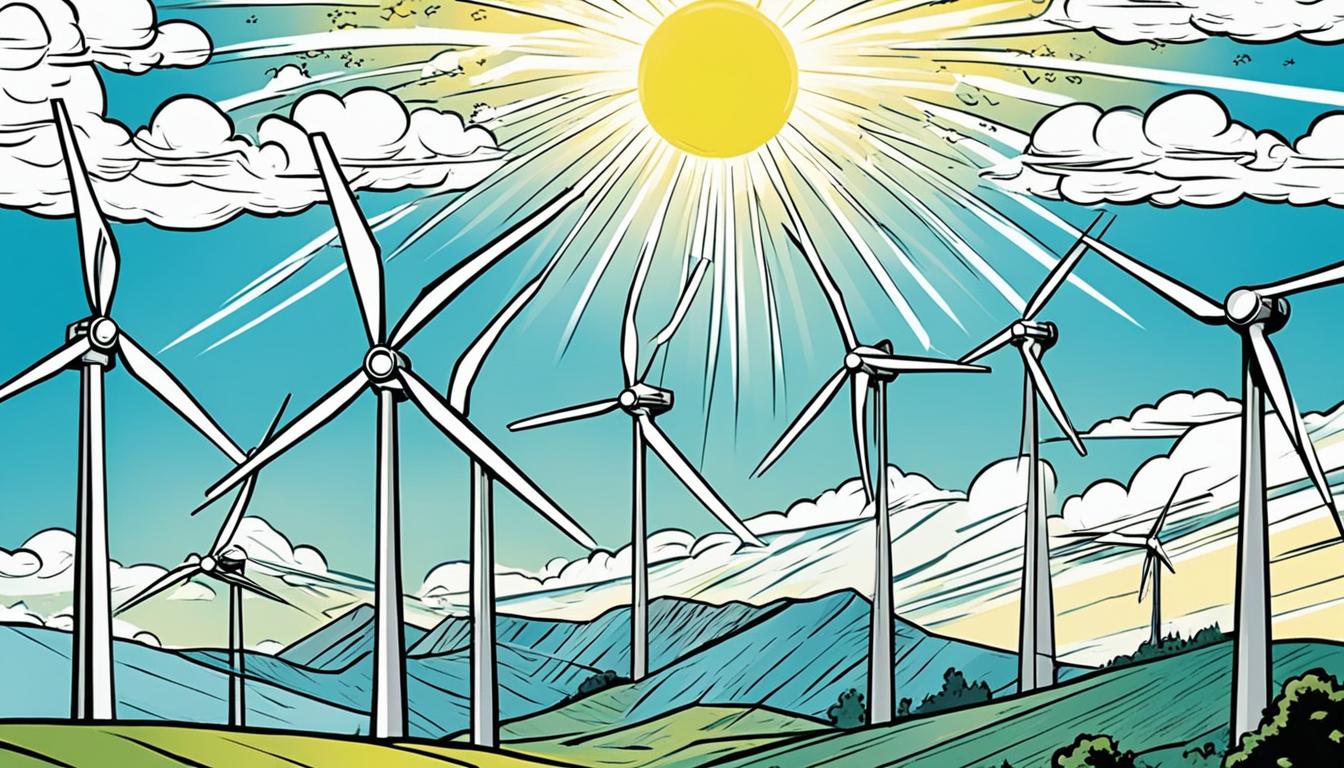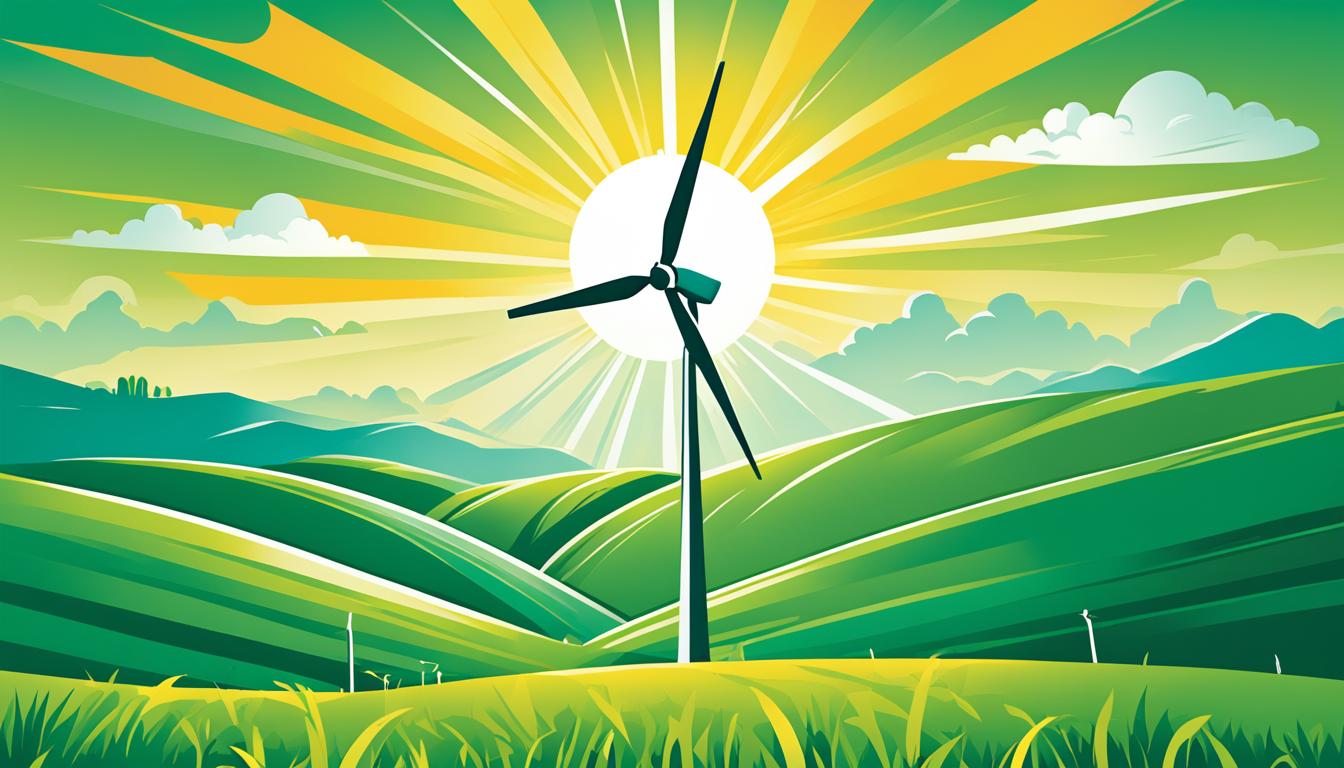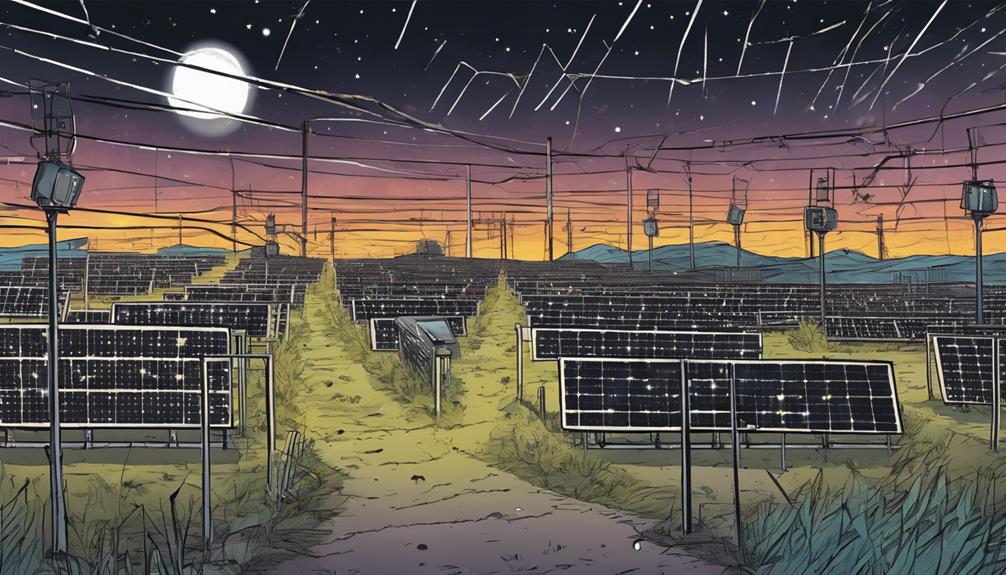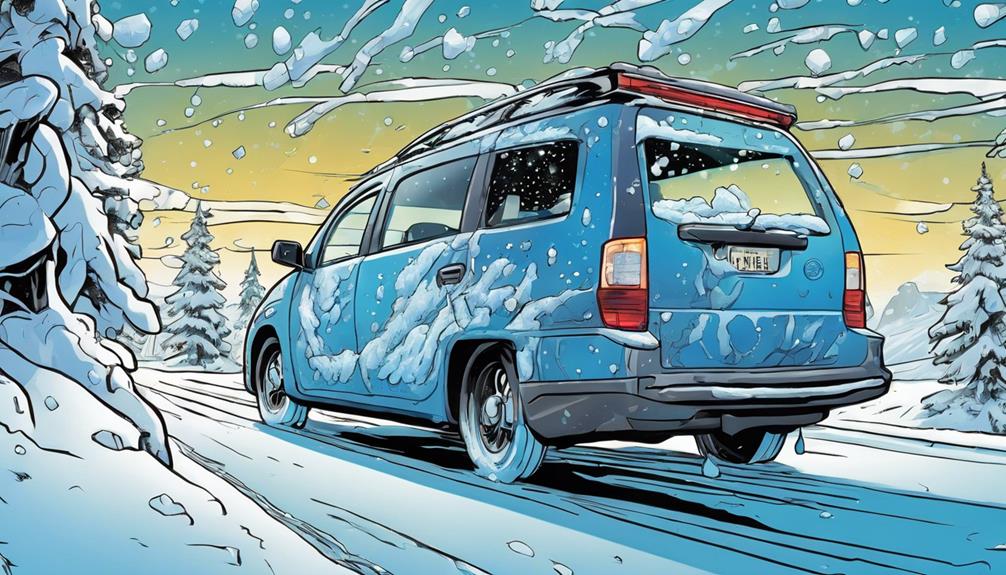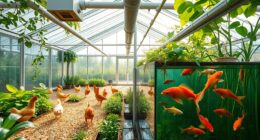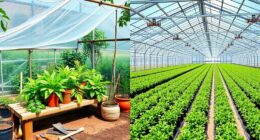Did you know wind turbines can turn wind into electricity? This makes them a key part of renewable energy. Globally, by 2020, we had over1300,000 big wind turbines with three blades. These turbines play a big role in clean energy.
Want to know how wind turbines create energy? When the wind blows, it spins the blades. This action turns a rotor linked to a generator. As the rotor spins, it makes electricity. Some turbines convert it to match our electricity grid1.
Key Takeaways:
- Wind turbines use wind to make electricity, a green energy option1.
- They start working at very low wind speeds and are about 30%-40% efficient on average1.
- A single onshore turbine can make over 6 million kWh yearly. Offshore ones can make even more1.
- Wind farms have many turbines in windy spots to make a lot of power2.
- In Canada, wind energy could power up to 17 million homes2.
- Turbines are smart. They turn to face the wind for better performance and to protect themselves2.
- The wind’s energy near land and shores is more than the world’s total energy use3.
How Wind Turbines Work
Wind turbines turn wind power into clean, renewable electricity. This process involves several parts: blades, rotor, and generator.
Blades
The blades catch wind energy. They’re made from light, strong materials like fiberglass. This makes them good at turning wind into motion.
Rotor
The rotor connects to the blades. Wind causes the rotor to spin by changing air pressure on the blades. This spinning action comes from the lift being stronger than the drag.
Generator
The spinning rotor powers a generator, directly or via a gearbox. This generates electricity. The electrical energy goes to power grids or gets stored in batteries.
Wind turbines work best in windy places, like open fields or seas. They are placed high and in specific spots to catch as much wind as possible. This ensures they generate a lot of electricity.
Thanks to improvements4, wind turbines are now more efficient and sustainable. A single turbine produces fewer megawatts than a steam turbine. Yet, a wind farm with many turbines can match a power station’s output.
Wind turbines are also better for the planet. They emit hardly any carbon dioxide compared to coal plants. Plus, up to 95% of a turbine can be recycled. Efforts to find new uses for old blades are boosting wind power’s sustainability4.
Renown Electric and Wind Turbine Generator Maintenance
Maintaining wind turbines is key for their best performance. Renown Electric fixes generators and more, keeping turbines running smoothly5.
Types of Wind Turbines
There are two main types of wind turbines: horizontal-axis and vertical-axis6.
Horizontal-axis wind turbines, or HAWTs, are widely used. They have blades that rotate around a horizontal axis. This design lets them efficiently turn wind into electricity6.
Vertical-axis wind turbines, known as VAWTs, feature a spinning rotor on a vertical axis. They can vary in design, like the Darrieus model that looks like an eggbeater. VAWTs fit well in cities or crowded places because of their compact size6.
VAWTs work well no matter the wind’s direction. They don’t need to be moved to face the wind. Their blades stand upright, making them steady in changing winds. They’re also easier to put up and maintain, even on roofs7.
Bladeless wind turbines are gaining popularity. Unlike traditional turbines, they don’t have rotor blades. They use vertical-axes and new ways to catch wind. These turbines aim to be more efficient by reducing parts that can wear out6.
There’s also a growth in small and micro wind turbines. They are part of systems that let people produce their own electricity. Using these turbines helps save energy and protect the environment6.
Comparison of Horizontal-Axis and Vertical-Axis Wind Turbines:
| Horizontal-Axis Wind Turbines (HAWTs) | Vertical-Axis Wind Turbines (VAWTs) |
|---|---|
| Most common type | Suitable for compact and versatile applications |
| Rotor blades rotate around a horizontal axis | Rotor spins around a vertical axis |
| Design optimized for wind energy conversion | Easier installation and maintenance options |
| Requires yaw control to track wind direction | Blades positioned perpendicularly to the ground |
Choosing between horizontal-axis and vertical-axis wind turbines depends on many things. Think about space, wind, and what the project needs. Both types are good for making clean energy in a sustainable way7.
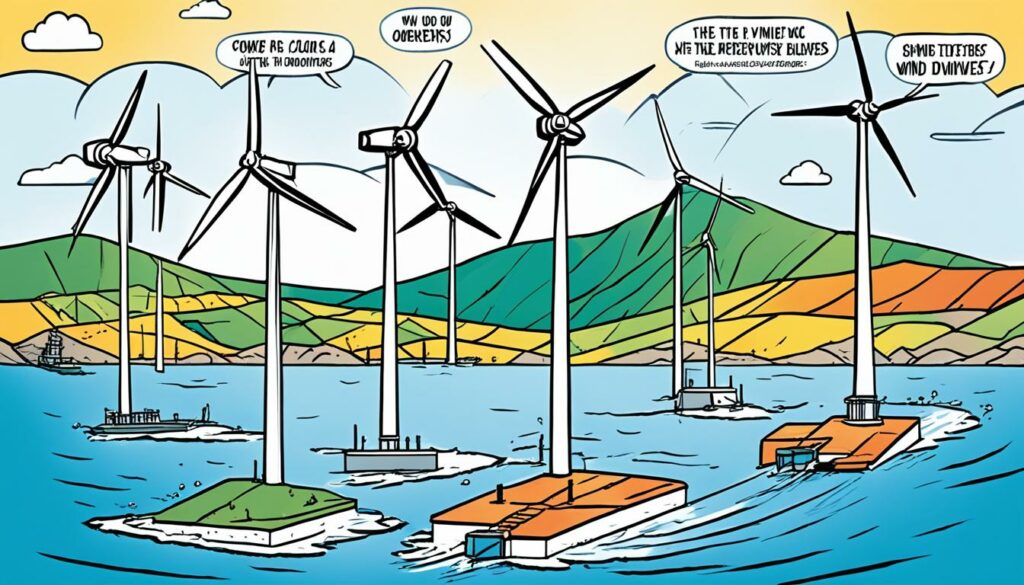
Applications of Wind Turbines
Wind turbines serve various purposes based on location and how they connect to the electrical grid. Land-based turbines vary in size. They can be as small as 100 kilowatts or as large as several megawatts. Groups of these turbines form wind plants that supply a lot of power to the grid8. Offshore turbines stand in water bodies like oceans. They’re taller than the Statue of Liberty and produce huge amounts of energy8. This makes wind power more than 10% of U.S. electricity, thanks to these offshore giants9.
Distributed wind turbines are usually smaller and found in homes, farms, and small businesses. They’re placed close to where electricity is used or on the customer’s side of the meter. These turbines, ranging from 1 to 10 kilowatts, are growing popular for off-grid uses8. They meet specific energy needs for a variety of places like schools, businesses, and farms9.
Wind turbines can combine with other energy sources like diesel generators and solar panels. This mix enhances their versatility and uses8. Large turbines in wind plants are cost-effective for supplying major power to the grid8. And, developers work with groups like the Royal Society for the Protection of Birds to protect wildlife10.
Wind turbines can also join forces with other renewable sources in hybrid power plants. This boosts efficiency and energy production9. Pairing with solar technology creates diverse, renewable energy systems9. Their flexible nature lets them meet various energy demands, aiming for a sustainable energy future.
Wind Turbine Locations
Wind farms are in the windiest areas to get the most energy. They are both on land and at sea.
Onshore Wind Turbine Locations
Onshore wind farms are on land, in open spaces where the wind doesn’t stop11. States like Texas and Iowa lead in wind power in the U.S., making up 59% of its wind energy in 202312. These places have great wind and lots of room for farms.
Offshore Wind Turbine Locations
Offshore farms are in the sea, catching stronger, steady winds11. By 2023, the U.S. had two working offshore wind projects in Rhode Island and Virginia12. They show the U.S.’s growing interest in offshore wind.
New offshore wind projects are planned off the U.S. East Coast. They could generate 5,251 MW of electricity by December 202312. With better tech and infrastructure, offshore wind could become a big player in green energy.
The UK is a leader in offshore wind power, aiming to power all homes with it by 203013. The Dogger Bank wind farm in the UK will have 200 huge turbines, as tall as The Shard13. This project shows the UK’s big plans for offshore wind.
Wind turbine spots are carefully picked for the best wind, terrain, and access to transmission lines. The aim is to make lots of energy with little downside for people and nature.
Wind Turbine Components
Wind turbines transform wind power into electricity using several parts. These include:
- Blades: Fiberglass blades catch the wind’s power and spin. GE’s Haliade-X turbine has the longest blades, measuring 351 feet14.
- Nacelle: Atop the tower, the nacelle keeps important parts like the gearbox or direct-drive system and generator. Direct-drive systems make turbines work better by avoiding gearbox problems14.
- Shaft: The blades link to a shaft inside the nacelle. This shaft turns when the wind makes the blades spin.
- Generator: The turning shaft activates the generator, creating electricity. This power lights up homes and businesses14.
- Yaw System: This system rotates the turbine to face the wind. It makes sure the blades get the most wind. If it doesn’t work well, the turbine might become unstable5.
- Pitch System: It changes the blade angle to keep the rotor speed ideal, making the turbine work its best. This is crucial for maximum efficiency5.
- Hub: The blades attach to the hub. It sends spinning energy from the blades to the shaft14.
- Controller: This part watches and manages how the turbine works. It’s key for safe and efficient operation14.
It’s important to regularly check and maintain wind turbine parts. Professionals trust companies like Santie Oil to provide lubricants that keep turbines running smoothly15.
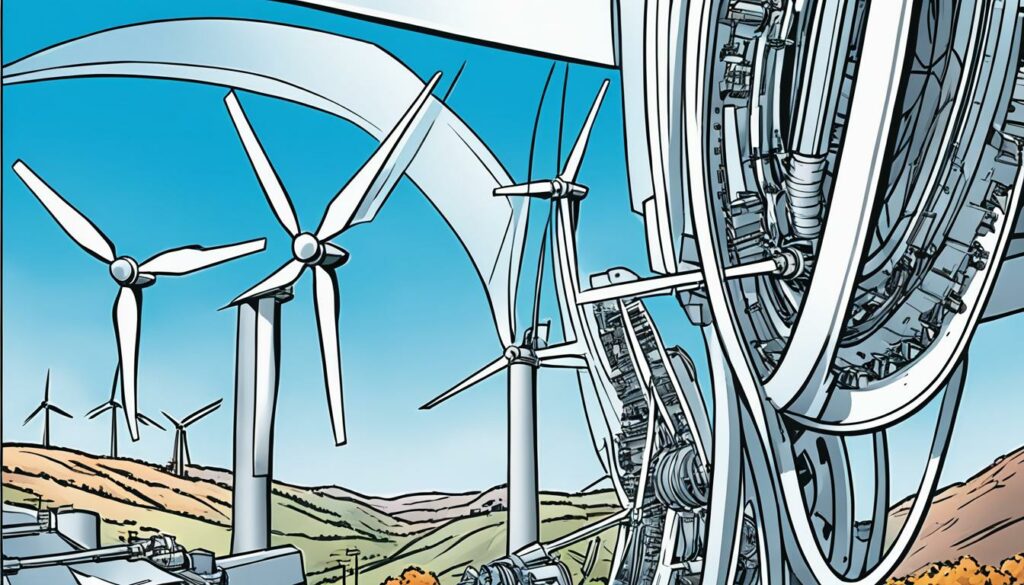
Wind Turbine Components Table:
| Component | Function | Additional Information |
|---|---|---|
| Blades | Capture the wind’s kinetic energy | The largest turbine has blades that are 351 feet (107 meters) long14 |
| Nacelle | Houses gearbox or direct-drive system and generator | Direct-drive turbines increase efficiency and reliability14 |
| Shaft | Connects the rotating blades to the generator | |
| Generator | Converts rotor’s rotational motion into electrical energy | |
| Yaw System | Enables the turbine to face the wind | Ineffective yaw systems can lead to turbine instability5 |
| Pitch System | Adjusts blade angle to optimize power production | |
| Hub | Central part to which blades are attached | |
| Controller | Monitors and controls wind turbine operation |
Wind Turbine Efficiency
Wind turbines start working at wind speeds of about 7-11 mph. They perform the best at speeds around 27 mph. Their efficiency peaks at roughly 18 mph. These turbines are made to grab as much energy from the wind as possible. Then, they turn it into electricity1617.
Evaluating efficiency is key for wind turbines. The Betz Limit states they can’t be more than 59.3% efficient in theory. But, most are 25-45% efficient in regular conditions. Overall, wind turbines are about 40% efficient. They do best at wind speeds of 4-8 m/s. They must also withstand very strong winds over 25 m/s17.
In the U.S., wind energy leads as the top renewable resource. It’s also among the cheapest ways to make electricity, especially with land-based farms. The U.S. aims to have 30 gigawatts of offshore wind energy by 2030. Coastal and Great Lakes states consume 80% of our electricity. Thus, offshore wind farms offer a great option. The first U.S. offshore wind farm started in Rhode Island in December 2016. Offshore turbines can be huge, with towers taller than the Washington Monument. Their blades are as long as a football field1718.
The wind energy sector is always looking for ways to get better. This includes new materials, designs, and technology to increase efficiency. It also seeks to lower noise, boost recyclability, and reduce wildlife impact. Distributed wind energy serves buildings, small communities, or grids. It goes from kilowatt-scale to several megawatts. Grid-tied wind plants start at 1 megawatt. The biggest U.S. wind farm covers 100,000 acres. It powers more than 250,000 homes18.
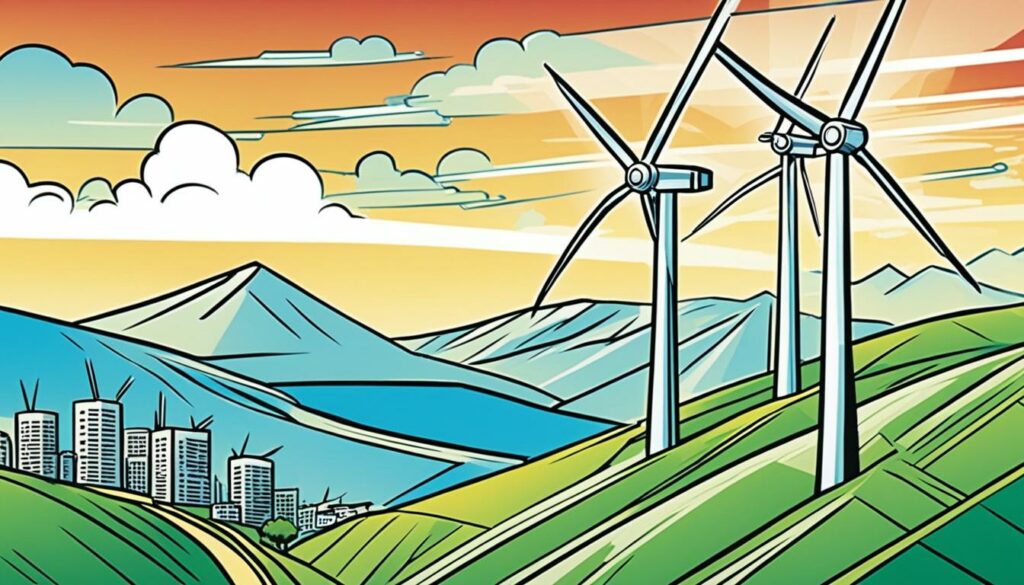
How well wind turbines work matters a lot. By optimizing wind speeds and using better tech and designs, they can efficiently make energy. This helps us move toward a sustainable energy future.
Advantages of Wind Turbine
Wind turbines play a key role in our shift to renewable energy. They bring several benefits, such as:
1. Clean and Renewable Energy
Wind energy is free from greenhouse gas emissions, like carbon dioxide. It offers a lasting solution for our energy demands. Wind is a never-ending resource.
2. Reduction of Greenhouse Gas Emissions
Using wind power greatly cuts down greenhouse gas emissions. In the U.S., wind turbines prevent 336 million metric tons of carbon dioxide annually19. This helps in battling climate change.
3. Job Creation and Economic Growth
The wind sector is crucial for creating jobs and boosting the economy. It employs over 125,000 people in the U.S19.. The role of wind turbine service technician is growing fast19. Wind projects poured $20 billion into the U.S. economy in just one year19. It opens up jobs in many fields, like construction and maintenance20.
4. Cost-Competitiveness
Onshore wind turbines are among the cheapest energy sources19. In 2013, wind energy cost about 2.5 cents per kilowatt-hour. This is competitive with new gas power plants20. Wind power’s low operating costs are due to no fuel expenses21. In windy areas, it provides a low-cost energy option19.
5. Water Conservation
Wind energy uses less water compared to conventional power generation. In 2013, it saved 36.5 billion gallons of water. This helps save our precious water resources20.
6. Support from the Public
Many Americans support wind energy development. A Gallup poll in 2013 showed that more than 70% of respondents favored expanding wind energy20. A 2014 poll found 87% support in Midwest states like Illinois and Iowa20.
Wind turbines offer great benefits as a renewable energy source. They help reduce harmful emissions, create jobs, and secure a sustainable energy future.
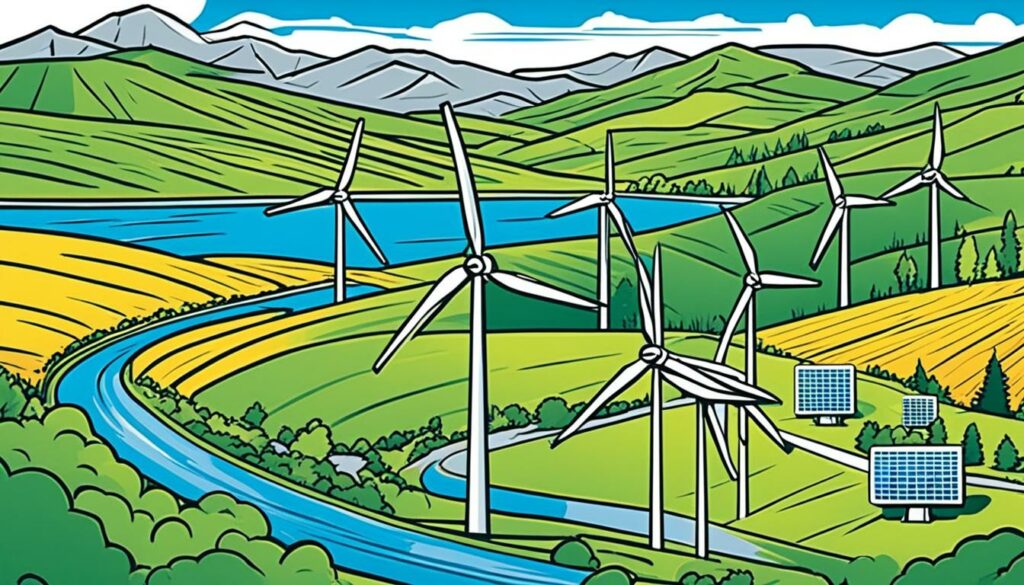
Conclusion
Wind turbines are key in making electricity and help grow renewable energy. They use wind to create clean, lasting power, cutting down our need for oil and gas. This move to green energy is essential for the US to fulfill its power needs and tackle environmental concerns22.
Studies show wind turbines could supply 10 percent of the US’s power if fully used22. In 2021, wind farms in Canada managed to produce 14,300 MW of power23.
The design of wind turbines, especially the number of blades, is vital. Six-blade turbines make the most power, not three as we thought. This design needs less wind to start, leading to more power made.
Still, wind energy faces challenges. The US wind power industry struggles with money issues, making it hard to keep up with world competition22. Yet, if we keep investing and supporting green policies, wind turbines will be crucial in our shift to a more eco-friendly future.
